Spatiotemporal Variation Characteristics of Groundwater Storage and Its Driving Factors and Ecological Effects in Tibetan Plateau
Abstract
:1. Introduction
2. Methodology
2.1. Study Area
2.2. Data Sources
2.2.1. GRACE/FO
2.2.2. GLDAS
2.2.3. Temperature and Precipitation
2.3. Vegetation Response
2.4. Method
2.4.1. Groundwater Storage Anomalies (GWSA)
2.4.2. Trend Test and Significance Analysis
2.4.3. Correlation Analysis
3. Results and Discussion
3.1. Spatial–Temporal Patterns of GWSA
3.2. The Influence of Climate Change on GWS in the TP
3.2.1. Fluctuation Characteristics of Regional Climate
3.2.2. Relationship between Climate Change and GWS
3.3. Ecological Effect of Groundwater Storage
3.3.1. Vegetation Change
3.3.2. Vegetation Responses to GWS Changes
4. Conclusions
- The higher values were mainly distributed in the QB, the IB, the source of the Yangtze River, and the southeastern edge of the TP. An increasing trend in the GWS was revealed in 42.0% of the plateau area and a decreasing trend was revealed in 58.0% of the plateau area. The areas where the GWS increased were mainly the HC, S-IRB, YZ-BRB, and the south and southwest of the IB.
- Overall, the GWS in the TP was decreasing at an average rate of −0.89 mm/a from January 2003 to December 2021. However, the GWS has been slowly rising at a rate of 1.47 mm/a since January 2016. This shows that the level of groundwater storage is gradually recovering.
- The different climate conditions in the different sub-regions had different impacts on the change in the GWS. The change in precipitation may be the main reason for the change in the GWS in the YB. Rising temperatures have a two-sided effect on the groundwater storage. On the one hand, the melting of ice and snow caused by rising temperatures will replenish the groundwater, which will increase the groundwater storage in some areas, such as the south of the IB. On the other hand, permafrost degradation caused by climate change will lead to a decrease in the GWS in other regions, such as the north of the IB.
- The potential ecological effects were investigated, with the results showing that the reduction in the GWS is an important cause of vegetation degradation. The decrease in the GWS reduced the efficiency of plant roots in absorbing and utilizing groundwater and eventually led to the degradation of 17.19 × 104 km2 of grassland to sand, desert, or other kinds of unused land on the TP.
Author Contributions
Funding
Data Availability Statement
Acknowledgments
Conflicts of Interest
References
- Yao, T.; Masson-Delmotte, V.; Gao, J.; Yu, W.; Yang, X.; Risi, C.; Sturm, C.; Werner, M.; Zhao, H.; He, Y.; et al. A review of climatic controls on δ18O in precipitation over the Tibetan Plateau: Observations and simulations. Rev. Geophys. 2013, 51, 525–548. [Google Scholar] [CrossRef]
- Wang, J.; Huang, L.; Ju, J.; Daut, G.; Ma, Q.; Zhu, L.; Haberzettl, T.; Baade, J.; Mäusbacher, R.; Hamilton, A.; et al. Seasonal stratification of a deep, high-altitude, dimictic lake: Nam Co, Tibetan Plateau. J. Hydrol. 2020, 584, 124668. [Google Scholar] [CrossRef]
- Yao, T.; Bolch, T.; Chen, D.; Gao, J.; Immerzeel, W.; Piao, S.; Su, F.; Thompson, L.; Wada, Y.; Wang, L.; et al. The imbalance of the Asian water tower. Nat. Rev. Earth Environ. 2022, 3, 618–632. [Google Scholar] [CrossRef]
- Chen, D.; Tan-Dong, Y. Climate change and its impact on the Third Pole and beyond. Adv. Clim. Chang. Res. 2021, 12, 297–298. [Google Scholar] [CrossRef]
- Xiaodong, L.; Baode, C. Climatic warming in the Tibetan Plateau during recent decades. Int. J. Climatol. 2000, 20, 1729–1742. [Google Scholar] [CrossRef]
- Kang, S.; Xu, Y.; You, Q.; Fluegel, W.-A.; Pepin, N.; Yao, T. Review of climate and cryospheric change in the Tibetan Plateau. Environ. Res. Lett. 2010, 5, 015101. [Google Scholar] [CrossRef]
- Li, X.; Long, D.; Scanlon, B.R.; Mann, M.E.; Li, X.; Tian, F.; Sun, Z.; Wang, G. Climate change threatens terrestrial water storage over the Tibetan Plateau. Nat. Clim. Chang. 2022, 12, 801–807. [Google Scholar] [CrossRef]
- Yao, T.D.; Thompson, L.; Yang, W.; Yu, W.S.; Gao, Y.; Guo, X.J.; Yang, X.X.; Duan, K.Q.; Zhao, H.B.; Xu, B.Q.; et al. Different glacier status with atmospheric circulations in Tibetan Plateau and surroundings. Nat. Clim. Chang. 2012, 2, 663–667. [Google Scholar] [CrossRef]
- He, Z.; Yang, W.; Wang, Y.J.; Zhao, C.X.; Ren, S.T.; Li, C.H. Dynamic Changes of a Thick Debris-Covered Glacier in the Southeastern Tibetan Plateau. Remote Sens. 2023, 15, 357. [Google Scholar] [CrossRef]
- Yongsheng, Z.; Li, T.; Bin, W. Decadal change of the spring snow depth over the Tibetan Plateau: The associated circulation and influence on the East Asian summer monsoon. J. Clim. 2004, 17, 2780–2793. [Google Scholar] [CrossRef]
- Zhaoxia, P.; Xu, L.; Salomonson, V.V. MODIS/Terra observed seasonal variations of snow cover over the Tibetan Plateau. Geophys. Res. Lett. 2007, 34, 137–161. [Google Scholar] [CrossRef]
- Zhang, G.Q.; Xie, H.J.; Kang, S.C.; Yi, D.H.; Ackley, S.F. Monitoring lake level changes on the Tibetan Plateau using ICESat altimetry data (2003-2009). Remote Sens. Environ. 2011, 115, 1733–1742. [Google Scholar] [CrossRef]
- Zhang, G.; Yao, T.; Xie, H.; Yang, K.; Zhu, L.; Shum, C.K.; Bolch, T.; Yi, S.; Allen, S.; Jiang, L.; et al. Response of Tibetan Plateau lakes to climate change: Trends, patterns, and mechanisms. Earth-Sci. Rev. 2020, 208, 103269. [Google Scholar] [CrossRef]
- Ren, W.; Tian, L.D.; Shao, L.L. Temperature and precipitation control the seasonal patterns of discharge and water isotopic signals of the Nyang River on the southeastern Tibetan Plateau. J. Hydrol. 2023, 617, 129064. [Google Scholar] [CrossRef]
- Immerzeel, W.W.; Droogers, P.; de Jong, S.M.; Bierkens, M.F.P. Large-scale monitoring of snow cover and runoff simulation in Himalayan river basins using remote sensing. Remote Sens. Environ. 2009, 113, 40–49. [Google Scholar] [CrossRef]
- Xiang, L.; Wang, H.; Steffen, H.; Wu, P.; Jia, L.; Jiang, L.; Shen, Q. Groundwater storage changes in the Tibetan Plateau and adjacent areas revealed from GRACE satellite gravity data. Earth Planet. Sci. Lett. 2016, 452, 309. [Google Scholar] [CrossRef]
- Deng, H.J.; Pepin, N.C.; Liu, Q.; Chen, Y.N. Understanding the spatial differences in terrestrial water storage variations in the Tibetan Plateau from 2002 to 2016. Clim. Chang. 2018, 151, 379–393. [Google Scholar] [CrossRef]
- Gao, G.; Zhao, J.; Wang, J.; Zhao, G.; Chen, J.; Li, Z. Spatiotemporal Variation and Driving Analysis of Groundwater in the Tibetan Plateau Based on GRACE Downscaling Data. Water 2022, 14, 3302. [Google Scholar] [CrossRef]
- Khorrami, B.; Gunduz, O. Evaluation of the temporal variations of groundwater storage and its interactions with climatic variables using GRACE data and hydrological models: A study from Turkey. Hydrol. Process. 2021, 35, 3406–3425. [Google Scholar] [CrossRef]
- Han, Z.; Huang, S.; Huang, Q.; Bai, Q.; Leng, G.; Wang, H.; Zhao, J.; Wei, X.; Zheng, X. Effects of vegetation restoration on groundwater drought in the Loess Plateau, China. J. Hydrol. 2020, 591, 125566. [Google Scholar] [CrossRef]
- Zhang, H.; Ding, J.; Wang, Y.; Zhou, D.; Zhu, Q. Investigation about the correlation and propagation among meteorological, agricultural and groundwater droughts over humid and arid/semi-arid basins in China. J. Hydrol. 2021, 603, 127007. [Google Scholar] [CrossRef]
- Liu, F.; Kang, P.; Zhu, H.; Han, J.; Huang, Y. Analysis of Spatiotemporal Groundwater-Storage Variations in China from GRACE. Water 2021, 13, 2378. [Google Scholar] [CrossRef]
- Ahmed, M.; Aqnouy, M.; El Messari, J.S. Sustainability of Morocco’s groundwater resources in response to natural and anthropogenic forces. J. Hydrol. 2021, 603, 126866. [Google Scholar] [CrossRef]
- Sliwinska, J.; Birylo, M.; Rzepecka, Z.; Nastula, J. Analysis of Groundwater and Total Water Storage Changes in Poland Using GRACE Observations, In-situ Data, and Various Assimilation and Climate Models. Remote Sens. 2019, 11, 2949. [Google Scholar] [CrossRef]
- Hu, W.; Liu, H.; Bao, A.; El-Tantawi, A.M. Influences of environmental changes on water storage variations in Central Asia. J. Geogr. Sci. 2018, 28, 985–1000. [Google Scholar] [CrossRef]
- Liu, X.; Hu, L.; Sun, K.; Yang, Z.; Sun, J.; Yin, W. Improved Understanding of Groundwater Storage Changes under the Influence of River Basin Governance in Northwestern China Using GRACE Data. Remote Sens. 2021, 13, 2672. [Google Scholar] [CrossRef]
- Yang, K.; Wu, H.; Qin, J.; Lin, C.; Tang, W.; Chen, Y. Recent climate changes over the Tibetan Plateau and their impacts on energy and water cycle: A review. Glob. Planet. Chang. 2014, 112, 79–91. [Google Scholar] [CrossRef]
- Luo, J.; Ke, C.-Q.; Seehaus, T. The West Kunlun Glacier Anomaly and Its Response to Climate Forcing during 2002–2020. Remote Sens. 2022, 14, 3465. [Google Scholar] [CrossRef]
- Xu, L.; Gao, B. Understanding the Effects of Cold and Warm Season Air Warming on the Permafrost Hydrology Changes in the Source Region of the Lancang River, the Qinghai-Tibetan Plateau. J. Geophys. Res.-Atmos. 2022, 127, e2022JD036551. [Google Scholar] [CrossRef]
- Li, F.W.; Wang, Y.; Zhao, Y.; Qiao, J.L. Modelling the response of vegetation restoration to changes in groundwater level, based on ecologically suitable groundwater depth. Hydrogeol. J. 2018, 26, 2189–2204. [Google Scholar] [CrossRef]
- Zhang, H.; Wang, X.-S. The impact of groundwater depth on the spatial variance of vegetation index in the Ordos Plateau, China: A semivariogram analysis. J. Hydrol. 2020, 588, 125096. [Google Scholar] [CrossRef]
- Xu, M.; Kang, S.; Chen, X.; Wu, H.; Wang, X.; Su, Z. Detection of hydrological variations and their impacts on vegetation from multiple satellite observations in the Three-River Source Region of the Tibetan Plateau. Sci. Total Environ. 2018, 639, 1220–1232. [Google Scholar] [CrossRef]
- Wei, Y.Y.; Sun, S.G.; Liang, D.; Jia, Z.H. Spatial-temporal variations of NDVI and its response to climate in China from 2001 to 2020. Int. J. Digit. Earth 2022, 15, 1463–1484. [Google Scholar] [CrossRef]
- Gao, Y.; Zhou, X.; Wang, Q.; Wang, C.; Zhan, Z.; Chen, L.; Yan, J.; Qu, R. Vegetation net primary productivity and its response to climate change during 2001–2008 in the Tibetan Plateau. Sci. Total Environ. 2013, 444, 356–362. [Google Scholar] [CrossRef] [PubMed]
- Piao, S.; Tan, K.; Nan, H.; Ciais, P.; Fang, J.; Wang, T.; Vuichard, N.; Zhu, B. Impacts of climate and CO2 changes on the vegetation growth and carbon balance of Qinghai–Tibetan grasslands over the past five decades. Glob. Planet. Chang. 2012, 98–99, 73–80. [Google Scholar] [CrossRef]
- Zhang, B.; Zhou, W. Spatial-Temporal Characteristics of Precipitation and Its Relationship with Land Use/Cover Change on the Qinghai-Tibet Plateau, China. Land 2021, 10, 269. [Google Scholar] [CrossRef]
- Xu, W.; Su, X. Challenges and impacts of climate change and human activities on groundwater-dependent ecosystems in arid areas–A case study of the Nalenggele alluvial fan in NW China. J. Hydrol. 2019, 573, 376–385. [Google Scholar] [CrossRef]
- Zhang, G.Q.; Yao, T.D.; Xie, H.J.; Kang, S.C.; Lei, Y.B. Increased mass over the Tibetan Plateau: From lakes or glaciers? Geophys. Res. Lett. 2013, 40, 2125–2130. [Google Scholar] [CrossRef]
- Li, Y.; Su, F.; Chen, D.; Tang, Q. Atmospheric Water Transport to the Endorheic Tibetan Plateau and Its Effect on the Hydrological Status in the Region. J. Geophys. Res.-Atmos. 2019, 124, 12864–12881. [Google Scholar] [CrossRef]
- Wei, L.; Jiang, S.; Ren, L.; Tan, H.; Ta, W.; Liu, Y.; Yang, X.; Zhang, L.; Duan, Z. Spatiotemporal changes of terrestrial water storage and possible causes in the closed Qaidam Basin, China using GRACE and GRACE Follow-On data. J. Hydrol. 2021, 598, 126274. [Google Scholar] [CrossRef]
- Abhishek; Kinouchi, T.; Sayama, T. A comprehensive assessment of water storage dynamics and hydroclimatic extremes in the Chao Phraya River Basin during 2002-2020. J. Hydrol. 2021, 603, 126868. [Google Scholar] [CrossRef]
- Save, H.; Bettadpur, S.; Tapley, B.D. High-resolution CSR GRACE RL05 mascons. J. Geophys. Res.-Solid Earth 2016, 121, 7547–7569. [Google Scholar] [CrossRef]
- Yulong, Z.; Wei, F.; Min, Z.; Zutao, M. Dataset of Reconstructed Terrestrial Water Storage in China Based on Precipitation (2002–2019); National Tibetan Plateau Data Center: Beijing, China, 2020. [Google Scholar] [CrossRef]
- Zhong, Y.; Feng, W.; Humphrey, V.; Zhong, M. Human-Induced and Climate-Driven Contributions to Water Storage Variations in the Haihe River Basin, China. Remote Sens. 2019, 11, 3050. [Google Scholar] [CrossRef]
- Sun, Z.; Long, D.; Yang, W.; Li, X.; Pan, Y. Reconstruction of GRACE Data on Changes in Total Water Storage Over the Global Land Surface and 60 Basins. Water Resour. Res. 2020, 56, e2019WR026250. [Google Scholar] [CrossRef]
- Meng, F.; Su, F.; Li, Y.; Tong, K. Changes in Terrestrial Water Storage During 2003-2014 and Possible Causes in Tibetan Plateau. J. Geophys. Res.-Atmos. 2019, 124, 2909–2931. [Google Scholar] [CrossRef]
- Rodell, M.; Houser, P.R.; Jambor, U.; Gottschalc, J.; Mitchell, K.; Meng, C.-J.; Arsenault, K.; Cosgrove, A.; Radakovich, J.; Bosilovich, M.; et al. The Global Land Data Assimilation System. Bull. Amer. Meteor. Soc. 2004, 85, 381–394. [Google Scholar] [CrossRef]
- Beaudoing, H.; Rodell, M. NASA/GSFC/HSL. GLDAS Noah Land Surface Model L4 monthly 0.25 x 0.25 Degree V2.1; Goddard Earth Sciences Data and Information Services Center (GES DISC): Greenbelt, MD, USA, 2020. [CrossRef]
- Qu, W.; Jin, Z.; Zhang, Q.; Gao, Y.; Zhang, P.; Chen, P. Estimation of Evapotranspiration in the Yellow River Basin from 2002 to 2020 Based on GRACE and GRACE Follow-On Observations. Remote Sens. 2022, 14, 730. [Google Scholar] [CrossRef]
- Ramjeawon, M.; Demlie, M.; Toucher, M. Analyses of groundwater storage change using GRACE satellite data in the Usutu-Mhlatuze drainage region, north-eastern South Africa. J. Hydrol.-Reg. Stud. 2022, 42, 101118. [Google Scholar] [CrossRef]
- Harris, I.; Osborn, T.J.; Jones, P.; Lister, D. Version 4 of the CRU TS monthly high-resolution gridded multivariate climate dataset. Sci. Data 2020, 7, 109. [Google Scholar] [CrossRef]
- Liu, Y.; Tian, J.; Liu, R.; Ding, L. Influences of Climate Change and Human Activities on NDVI Changes in China. Remote Sens. 2021, 13, 4326. [Google Scholar] [CrossRef]
- Jin, H.; Chen, X.; Wang, Y.; Zhong, R.; Zhao, T.; Liu, Z.; Tu, X. Spatio-temporal distribution of NDVI and its influencing factors in China. J. Hydrol. 2021, 603, 127129. [Google Scholar] [CrossRef]
- Chang, X.; Xing, Y.; Wang, J.; Yang, H.; Gong, W. Effects of land use and cover change (LUCC) on terrestrial carbon stocks in China between 2000 and 2018. Resour. Conserv. Recycl. 2022, 182, 106333. [Google Scholar] [CrossRef]
- Guan, Q.; Yang, L.; Pan, N.; Lin, J.; Xu, C.; Wang, F.; Liu, Z. Greening and Browning of the Hexi Corridor in Northwest China: Spatial Patterns and Responses to Climatic Variability and Anthropogenic Drivers. Remote Sens. 2018, 10, 1270. [Google Scholar] [CrossRef]
- Hamed, K.H. Exact distribution of the Mann–Kendall trend test statistic for persistent data. J. Hydrol 2008, 365, 86–94. [Google Scholar] [CrossRef]
- Guclu, Y.S. Improved visualization for trend analysis by comparing with classical Mann-Kendall test and ITA. J. Hydrol. 2020, 584, 124674. [Google Scholar] [CrossRef]
- Hamed, K.H.; Ramachandra Rao, A. A modified Mann-Kendall trend test for autocorrelated data. J. Hydrol. 1998, 204, 182–196. [Google Scholar] [CrossRef]
- Liu, Y.; Jia, Z.F.; Ma, X.Y.; Wang, Y.Q.; Guan, R.H.; Guan, Z.L.; Gu, Y.H.; Zhao, W. Analysis of Drought Characteristics Projections for the Tibetan Plateau Based on the GFDL-ESM2M Climate Model. Remote Sens. 2022, 14, 5084. [Google Scholar] [CrossRef]
- Kuang, X.X.; Jiao, J.J. Review on climate change on the Tibetan Plateau during the last half century. J. Geophys. Res.-Atmos. 2016, 121, 3979–4007. [Google Scholar] [CrossRef]
- Lei, Y.B.; Yang, K.; Wang, B.; Sheng, Y.W.; Bird, B.W.; Zhang, G.Q.; Tian, L.D. Response of inland lake dynamics over the Tibetan Plateau to climate change. Clim. Chang. 2014, 125, 281–290. [Google Scholar] [CrossRef]
- Ge, S.; McKenzie, J.; Voss, C.; Wu, Q. Exchange of groundwater and surface-water mediated by permafrost response to seasonal and long term air temperature variation. Geophys. Res. Lett. 2011, 38. [Google Scholar] [CrossRef]
- Shao, Q.; Liu, J.; Huang, L.; Fan, J.; Xu, X.; Wang, J. Integrated assessment on the effectiveness of ecological conservation in Sanjiangyuan National Nature Reserve (in Chinese). Geogr. Res. 2013, 32, 1645–1656. [Google Scholar]
- Zhao, L.; Zou, D.; Hu, G.; Wu, T.; Du, E.; Liu, G.; Xiao, Y.; Li, R.; Pang, Q.; Qiao, Y.; et al. A synthesis dataset of permafrost thermal state for the Qinghai-Tibet (Xizang) Plateau, China. Earth Syst. Sci. Data 2021, 13, 4207–4218. [Google Scholar] [CrossRef]
- Li, R.; Zhao, L.; Ding, Y.J.; Wu, T.H.; Xiao, Y.; Du, E.J.; Liu, G.Y.; Qiao, Y.P. Temporal and spatial variations of the active layer along the Qinghai-Tibet Highway in a permafrost region. Chin. Sci. Bull. 2012, 57, 4609–4616. [Google Scholar] [CrossRef]
- Peng, X.; Wu, Q.; Tian, M. The Effect of Groundwater Table Lowering on Ecological Environment in the Headwaters for the Yellow River. J. Glaciol. Geocryol. 2003, 25, 667–671. (In Chinese) [Google Scholar]
- Chang, J.; Ye, R.; Wang, G. Review: Progress in permafrost hydrogeology in China. Hydrogeol. J. 2018, 26, 1387–1399. [Google Scholar] [CrossRef]
- Cheng, G.D.; Jin, H.J. Permafrost and groundwater on the Qinghai-Tibet Plateau and in northeast China. Hydrogeol. J. 2013, 21, 5–23. [Google Scholar] [CrossRef]
- Huijun, J.; Ruixia, H.; Guodong, C.; Qingbai, W.; Shaoling, W.; Lanzhi, L.; Xiaoli, C. Changes in frozen ground in the Source Area of the Yellow River on the Qinghai-Tibet Plateau, China, and their eco-environmental impacts. Environ. Res. Lett. 2009, 4, 045206. [Google Scholar] [CrossRef]
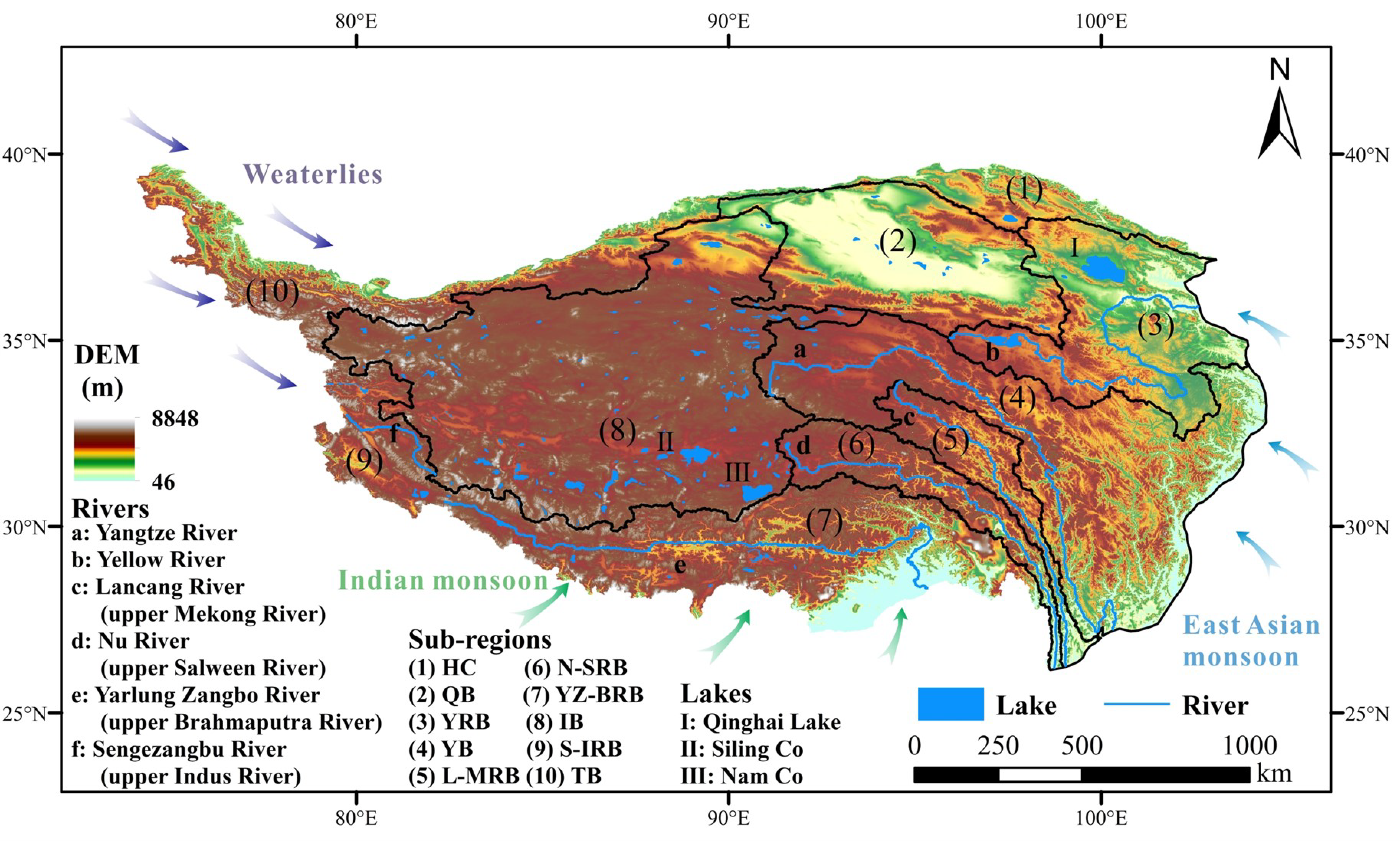
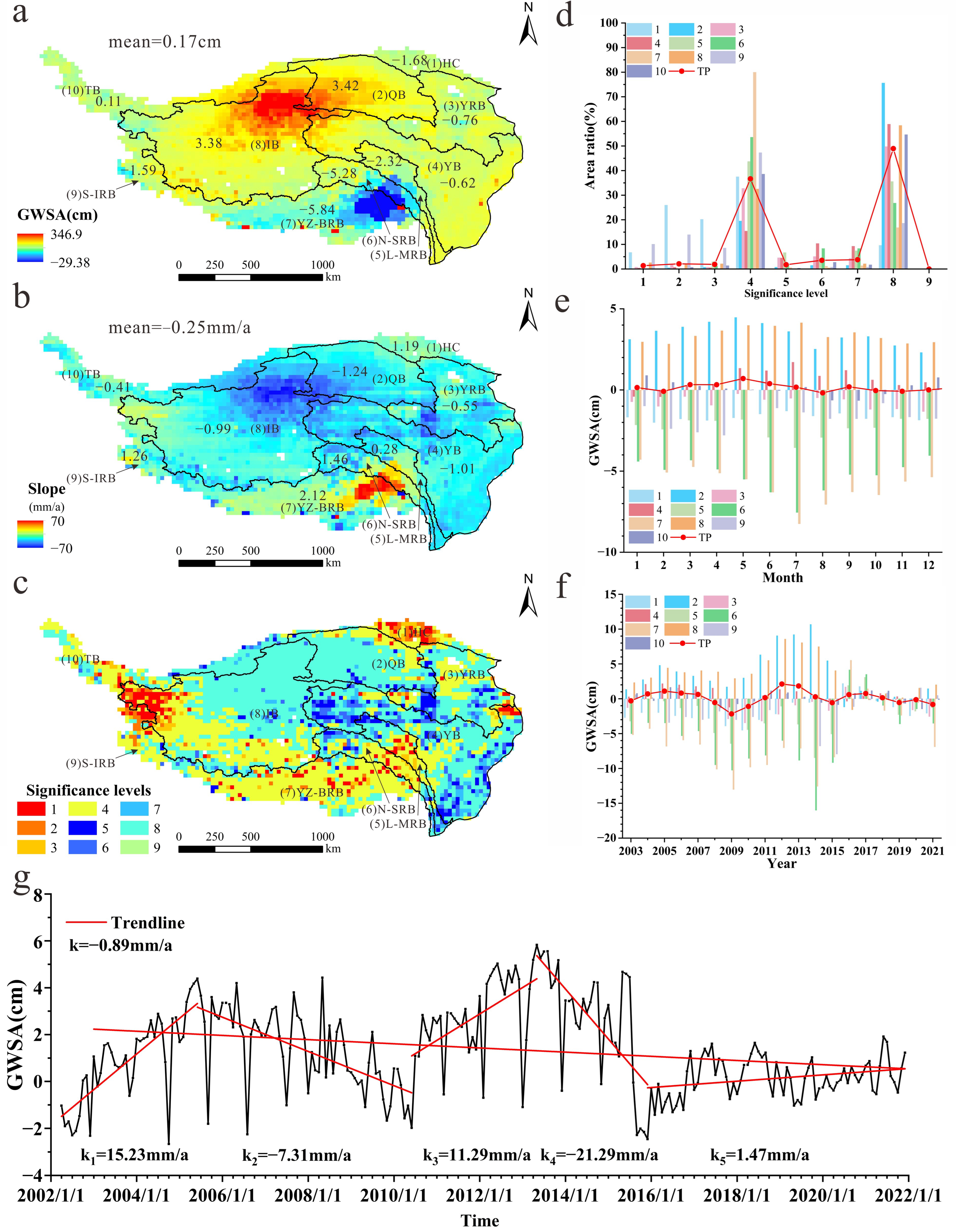

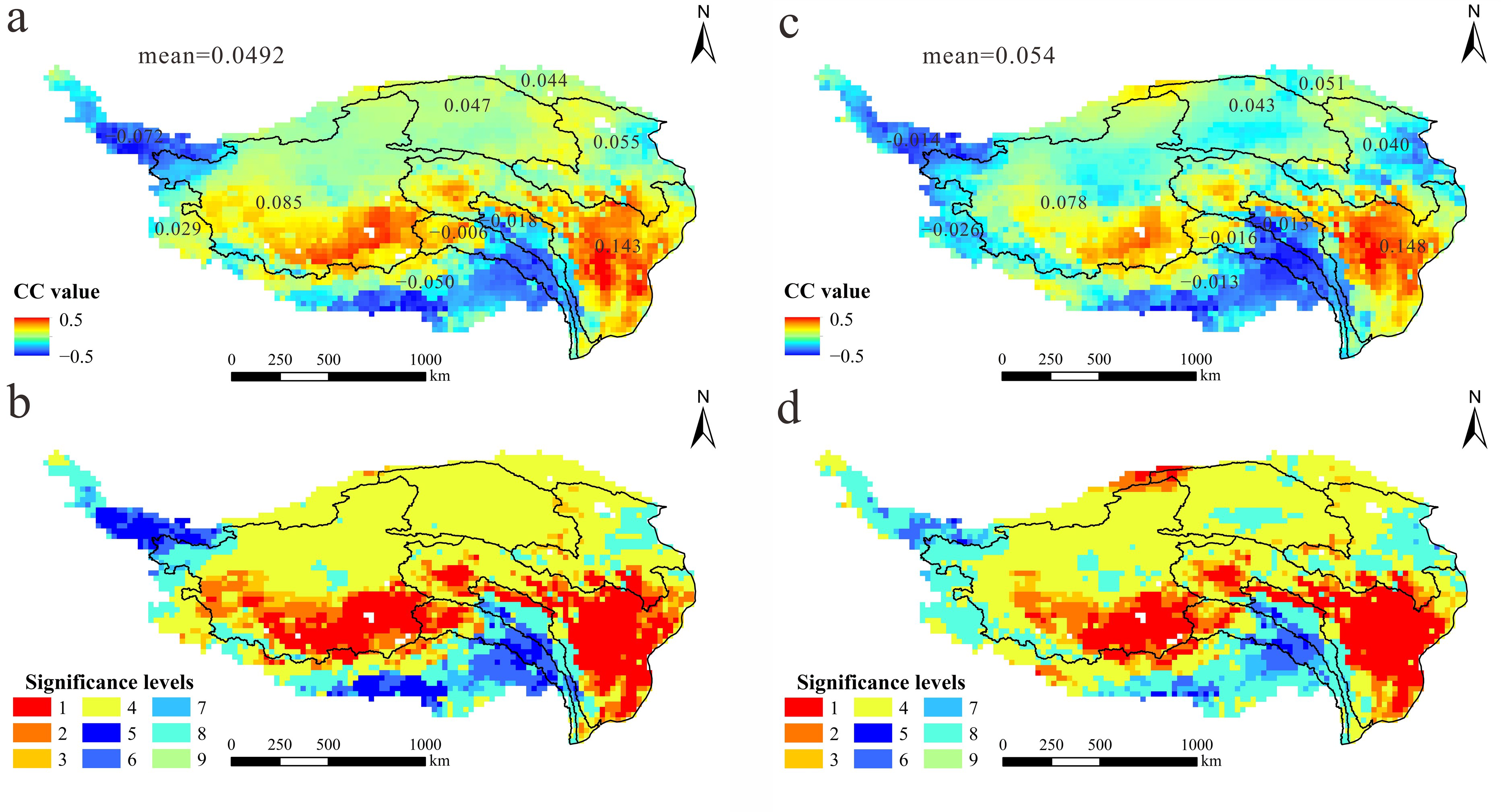
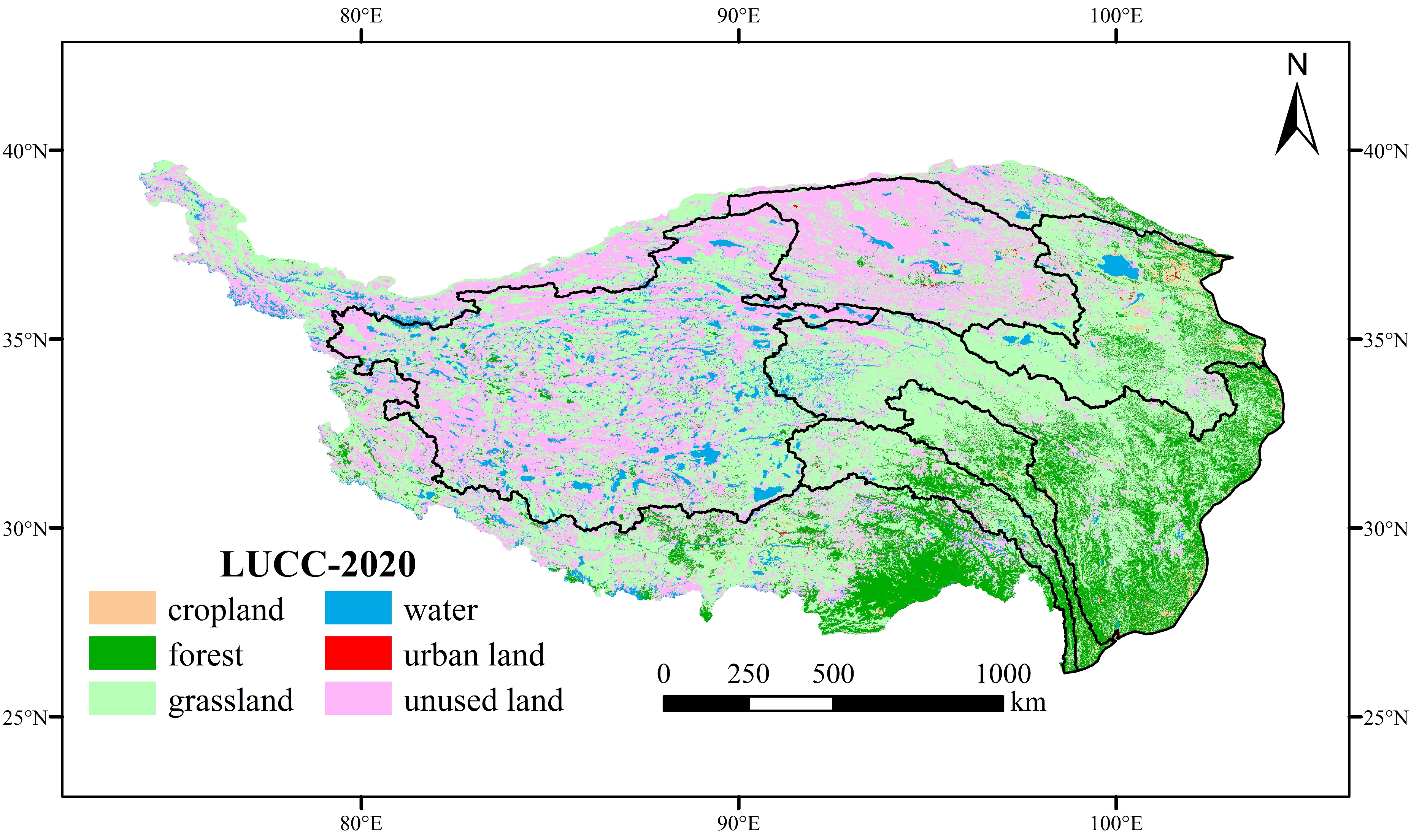
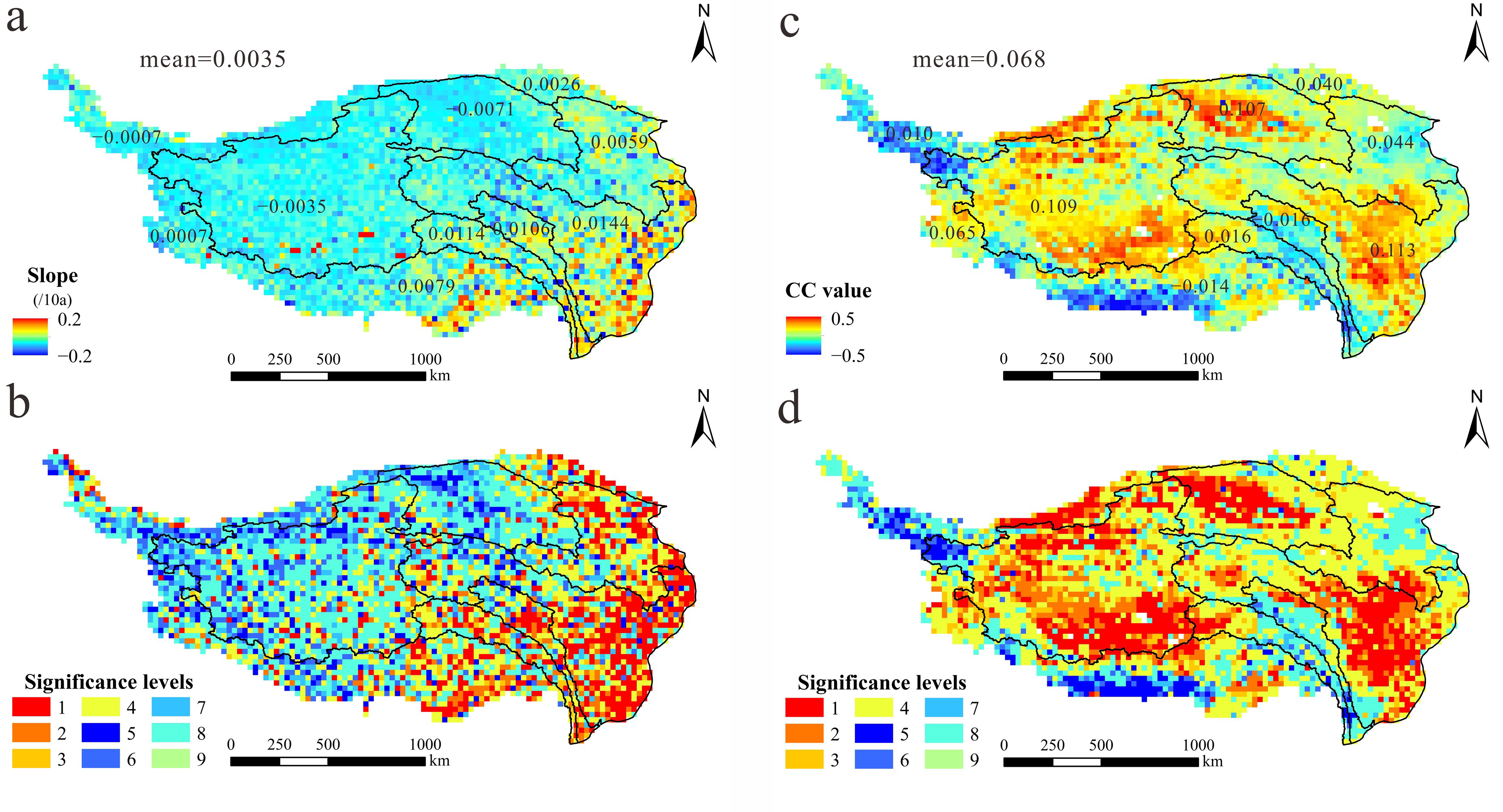
| Level | Description of the Trend or Correlation | Slope or CC | p | |Z| |
|---|---|---|---|---|
| 1 | Extremely significant increase or positive correlation | >0 | p < 0.01 | |Z| > 2.58 |
| 2 | Significant increase or positive correlation | 0.01 < p ≤ 0.05 | 1.96 < |Z| ≤ 2.58 | |
| 3 | Weakly significant increase or positive correlation | 0.05 < p ≤ 0.1 | 1.64 < |Z| ≤ 1.96 | |
| 4 | Insignificant increase or positive correlation | p > 0.1 | |Z| ≤ 1.64 | |
| 5 | Extremely significant decrease or negative correlation | <0 | p < 0.01 | |Z| > 2.58 |
| 6 | Significant decrease or negative correlation | 0.01 < p ≤ 0.05 | 1.96 < |Z| ≤ 2.58 | |
| 7 | Weakly significant decrease or negative correlation | 0.05 < p ≤ 0.1 | 1.64 < |Z| ≤ 1.96 | |
| 8 | Insignificant decrease or negative correlation | p > 0.1 | |Z| ≤ 1.64 | |
| 9 | Unchanged or uncorrelated | =0 | - | - |
| Basin | Cropland | Forest | Grassland | Water | Urban Land | Unused Land | |
|---|---|---|---|---|---|---|---|
| HC | Area | 0.009 | 0.382 | 2.181 | 0.200 | 0.002 | 2.027 |
| Changed area | 0.002 | 0.001 | 0.017 | 0.080 | 0.001 | −0.125 | |
| QB | Area | 0.061 | 0.169 | 5.730 | 0.522 | 0.035 | 12.090 |
| Changed area | 0.009 | −0.006 | 0.106 | 0.171 | 0.015 | −0.294 | |
| YRB | Area | 0.634 | 2.022 | 12.367 | 0.696 | 0.093 | 2.121 |
| Changed area | −0.010 | 0.015 | 0.654 | 0.066 | 0.033 | −0.762 | |
| YB | Area | 0.745 | 9.313 | 18.935 | 0.723 | 0.041 | 3.197 |
| Changed area | 0.044 | 0.388 | 0.210 | 0.059 | 0.023 | −0.694 | |
| L-MRB | Area | 0.150 | 1.720 | 3.870 | 0.063 | 0.003 | 0.398 |
| Changed area | 0.046 | 0.242 | −0.060 | 0.028 | 0.002 | −0.247 | |
| N-SRB | Area | 0.046 | 1.664 | 4.429 | 0.166 | 0.005 | 1.266 |
| Changed area | −0.001 | 0.355 | 0.128 | −0.032 | 0.004 | −0.447 | |
| YZ-BRB | Area | 0.339 | 7.097 | 11.342 | 1.093 | 0.027 | 5.920 |
| Changed area | 0.090 | 0.920 | −2.278 | −0.158 | 0.019 | 1.486 | |
| IB | Area | 0.001 | 0.692 | 21.507 | 4.752 | 0.002 | 22.990 |
| Changed area | 0.001 | 0.681 | −14.926 | 2.022 | 0.002 | 12.284 | |
| S-IRB | Area | 0.001 | 0.376 | 3.036 | 0.375 | 0.002 | 2.962 |
| Changed area | 0.001 | 0.374 | −1.840 | 0.164 | 0.002 | 1.321 | |
| TB | Area | 0.007 | 0.023 | 5.889 | 0.989 | 0.001 | 6.765 |
| Changed area | 0.006 | −0.001 | 0.800 | −0.449 | 0.001 | −0.342 | |
| The TP | Area | 1.994 | 23.457 | 89.285 | 9.577 | 0.210 | 59.736 |
| Changed area | 0.19 | 2.97 | −17.19 | 1.96 | 0.10 | 12.18 | |
Disclaimer/Publisher’s Note: The statements, opinions and data contained in all publications are solely those of the individual author(s) and contributor(s) and not of MDPI and/or the editor(s). MDPI and/or the editor(s) disclaim responsibility for any injury to people or property resulting from any ideas, methods, instructions or products referred to in the content. |
© 2023 by the authors. Licensee MDPI, Basel, Switzerland. This article is an open access article distributed under the terms and conditions of the Creative Commons Attribution (CC BY) license (https://creativecommons.org/licenses/by/4.0/).
Share and Cite
Ren, W.; Gao, Y.; Qian, H.; Ma, Y.; Su, Z.; Ma, W.; Liu, Y.; Xu, P. Spatiotemporal Variation Characteristics of Groundwater Storage and Its Driving Factors and Ecological Effects in Tibetan Plateau. Remote Sens. 2023, 15, 2418. https://doi.org/10.3390/rs15092418
Ren W, Gao Y, Qian H, Ma Y, Su Z, Ma W, Liu Y, Xu P. Spatiotemporal Variation Characteristics of Groundwater Storage and Its Driving Factors and Ecological Effects in Tibetan Plateau. Remote Sensing. 2023; 15(9):2418. https://doi.org/10.3390/rs15092418
Chicago/Turabian StyleRen, Wenhao, Yanyan Gao, Hui Qian, Yaoming Ma, Zhongbo Su, Weiqiang Ma, Yu Liu, and Panpan Xu. 2023. "Spatiotemporal Variation Characteristics of Groundwater Storage and Its Driving Factors and Ecological Effects in Tibetan Plateau" Remote Sensing 15, no. 9: 2418. https://doi.org/10.3390/rs15092418







